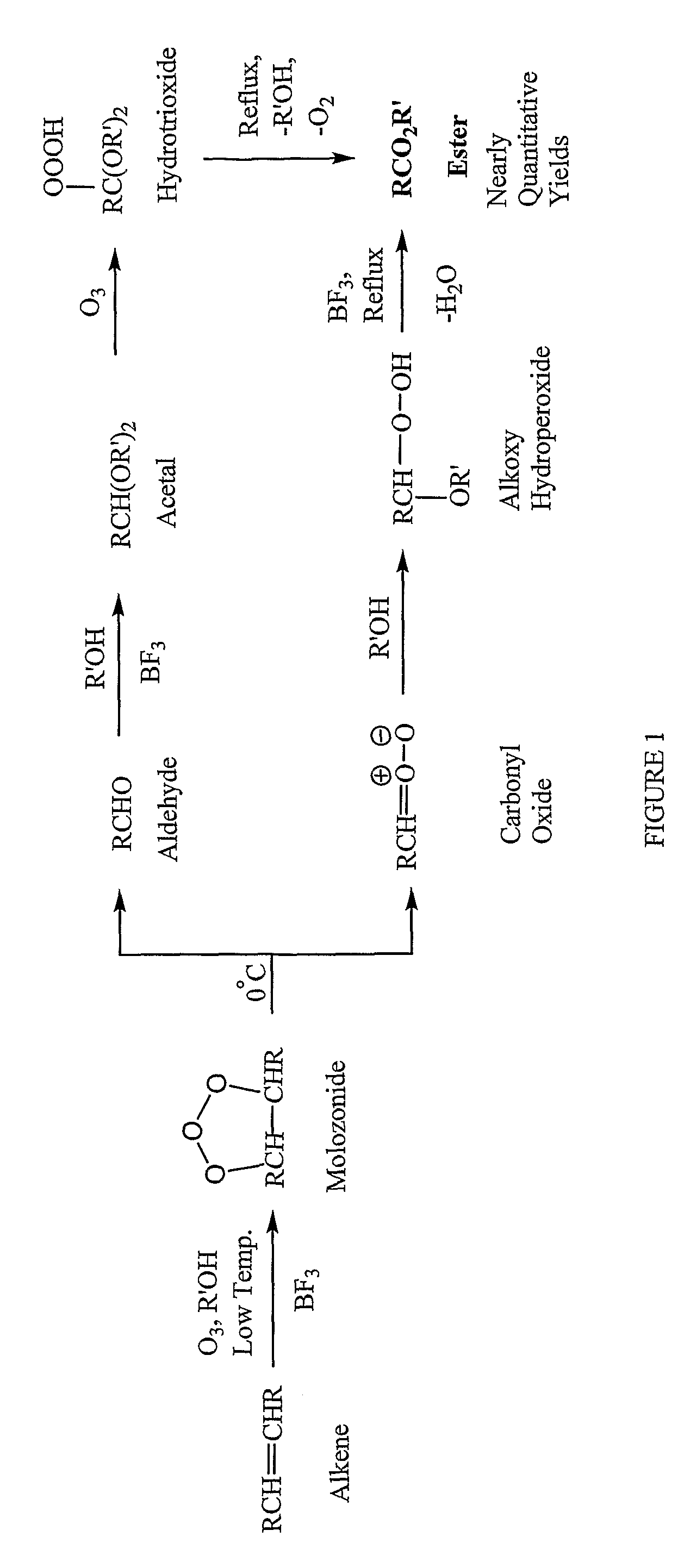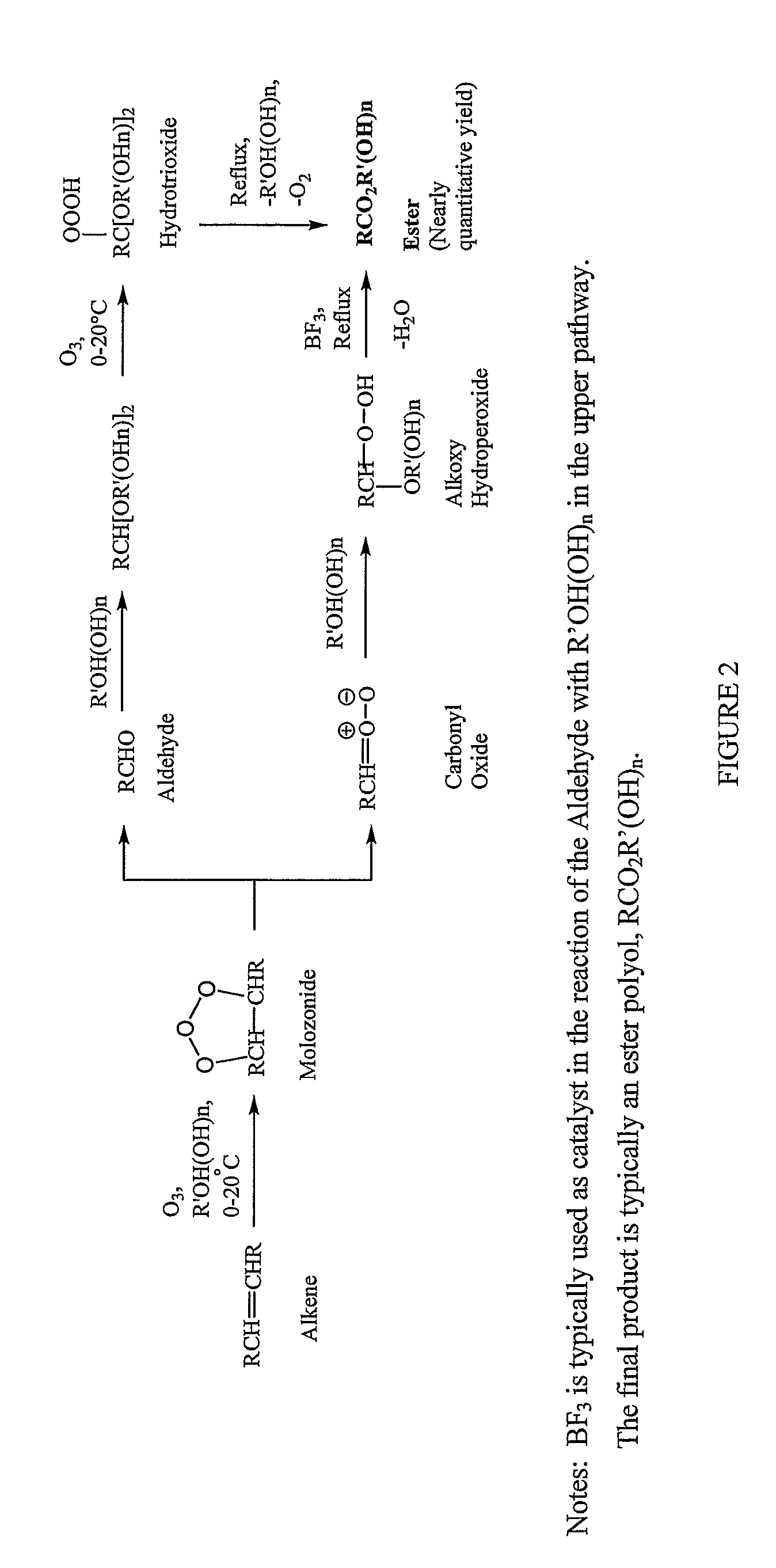Methods for production of polyols from oils and their use in the production of polyesters and polyurethanes
a technology of polyols and oils, which is applied in the preparation of carboxylic compounds, fatty acid oxidation, fatty acid chemical modification, etc., can solve the problems of expensive transition metal catalysts in both steps and inability to readily hydroxyla
- Summary
- Abstract
- Description
- Claims
- Application Information
AI Technical Summary
Problems solved by technology
Method used
Image
Examples
example 1
[0060]This example shows a procedure for making glyceride alcohols or primarily soybean oil monoglycerides as shown in FIG. 3 (also including products such as those in FIG. 9 A, B, C).
[0061]All steps for making glyceride alcohols were performed under a blanket of Argon. The ozonolysis of soybean oil was carried out by first weighing 20.29 grams of soybean oil (0.02306 mole; 0.02036×12=0.2767 mole double bond plus triglyceride reactive sites) and 101.34 grams of glycerol (1.10 mole; 4 fold molar excess) into a 500 mL 3-neck round bottom flask. A magnetic stirrer, ethyl acetate (300 mL) and boron trifluoride diethyl etherate (8.65 mL) were added to the round bottom flask. A thermocouple, sparge tube, and condenser (with a gas inlet attached to a bubbler containing potassium iodide (1 wt %) in starch solution (1%) were attached to the round bottom flask. The round bottom flask was placed into a water-ice bath on a magnetic stir plate to maintain the internal temperature at 10-20° C., a...
example 2
[0063]This example shows the production of soybean oil transesterified with propylene glycol or glycerin as shown in FIG. 8.
[0064]Soybean oil was added to a flask containing propylene glycol (1 mole soybean oil / 6 mole propylene glycol) and lithium carbonate (1.5 wt % of soybean oil), and the flask was heated at 185° C. for 14 hrs. The product was rinsed with hot distilled water and dried. Proton NMR spectroscopy indicated the presence of 1-propylene glycol monoester and no mono-, di- or triglycerides.
[0065]When reacting with glycerol, a working ratio of 1 mole soybean oil / 20 mole glycerol was used when the reaction was performed at 220° C. for 100 hrs to maximize the amount of monoglycerides that gave a composition containing 70% monoglycerides, 29% diglycerides and a trace of triglyceride (glyceryl soyate).
example 3
[0066]This example shows production of a mixed ester alcohol, as in FIG. 9D.
[0067]Soybean oil was initially transesterified with glycerin as specified in Example 2 to produce glyceryl soyate. 50.0 g glyceryl soyate was reacted with ozone in the presence of 130 g propylene glycol, boron trifluoride etherate (13.4 mL) in chloroform (500 mL). The ozonolysis was performed at ambient temperature until indicated to be complete by passing the effluent gases from the reaction into a 1% potassium iodide / starch ozone-indicating solution and refluxing the ozonolysis solution for one hour. The mixture was stirred with 60 g sodium carbonate for 20 hours and filtered. The resulting solution was initially evaporated on a rotary evaporator and a short path distillation apparatus (a Kugelrohr apparatus) was used to vacuum distill the excess propylene glycol at 80° C. and 0.25 Torr. The final product is a hybrid ester alcohol with pendent glycerin and propylene glycol hydroxyl groups with respect to ...
PUM
| Property | Measurement | Unit |
|---|---|---|
| Temperature | aaaaa | aaaaa |
| Temperature | aaaaa | aaaaa |
| Temperature | aaaaa | aaaaa |
Abstract
Description
Claims
Application Information
 Login to View More
Login to View More - R&D
- Intellectual Property
- Life Sciences
- Materials
- Tech Scout
- Unparalleled Data Quality
- Higher Quality Content
- 60% Fewer Hallucinations
Browse by: Latest US Patents, China's latest patents, Technical Efficacy Thesaurus, Application Domain, Technology Topic, Popular Technical Reports.
© 2025 PatSnap. All rights reserved.Legal|Privacy policy|Modern Slavery Act Transparency Statement|Sitemap|About US| Contact US: help@patsnap.com



